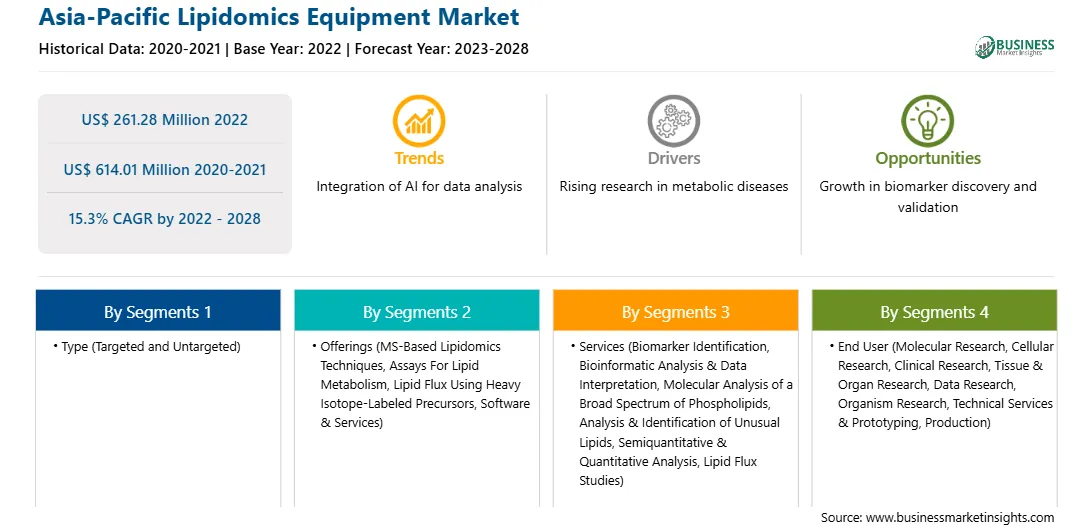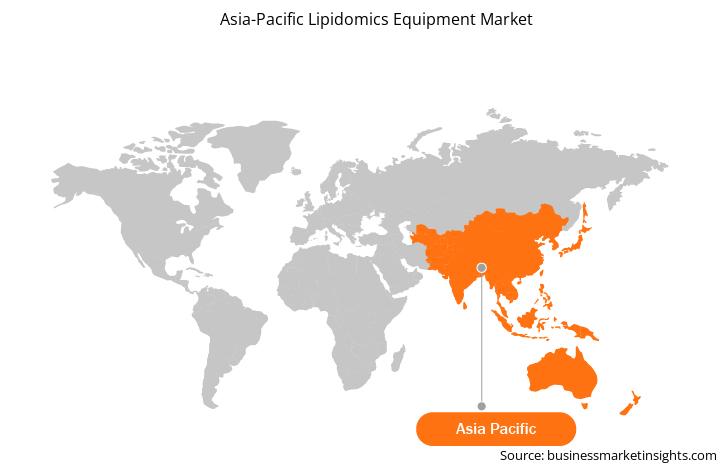Escalating Investments by Governments and Market Players is Driving the Asia-Pacific Lipidomics Equipment Market
The biopharmaceutical industry invests enormously in research and development. Together, China and India generate a huge demand for lipidomics equipment due to the large number of projects underway in several end-user industries in these countries. Further, key market players are establishing new R&D and innovation centers in Asian countries and collaborating with local players to capitalize on opportunities provided by these countries. For instance, The China MS Center was established in the Beijing branch of Shimadzu (China) Co., Ltd. in October 2015 as a research and development facility to increase the market share of mass spectrometers and promote joint research and joint development projects in the local area. Further, government and private universities are undertaking several initiatives to spread awareness about lipidomics and its applications. For example, in 2018, the Department of Science and Technology (DST-FIST) of the Government of India and Amity University established Amity Lipidomics Research Facility (ALRF). In August 2022, Amity University conducted a week-long "hands-on training on materials characterization, lipidomics, and proteomics technique," which was sponsored by the DST under its "Synergistic Training program Utilizing the Scientific and Technological Infrastructure (STUTI)." Moreover, Central Food Technological Research Institute (CSIR) also opened a lipidomic center. The center was successfully established in 2016, and it gives access to a wide range of instruments required for high-end lipid research. Therefore, the growing investment is driving the Asia-Pacific lipidomics equipment market.
Asia-Pacific Lipidomics Equipment Market Overview
The Asia-Pacific lipidomics equipment market has been categorized into China, India, Japan, South Korea, Australia, and the Rest of Asia-Pacific. China dominated the market in 2022. The lipidomics equipment market in China is expected to grow during the forecast period owing to the factors such as growing chronic diseases, including cancer, in China and rising technological advancements in lipidomics equipment. As per Globocan 2020 report, lung cancer is the most common cancer in China, and 815,563 (17.9%) cases were registered in 2020. This is likely to increase the demand for various therapeutics and medicines in China. Further, 555,477 (12.2%) new cases of colorectal cancer, 478,508 (10.5%) cases of stomach cancer, 410,038 (9%) cases of liver cancer, 416,371 (9.1%) cases of breast cancer, and 1,892,797 (41.4%) cases of other cancers were found in China in 2020. The increasing prevalence of cancer in China is contributing to the growth of the lipidomics equipment market, owing to the application of equipment in research and diagnosis procedures. China has seen a rapid increase in investment in the healthcare industry, especially in the country's approach to precision medicine. Precision medicine is being adopted and put into practice rapidly on a large scale in China. The country's healthcare system has seen a significant transformation since the China Precision Medicine Initiative launched in 2016—a 15-year program with US$ 9,200 million in funding—which intends to enhance the nation's reputation in precision medicine. The increasing demand for precision medicine is expected to provide an opportunity for Asia-Pacific lipidomics equipment market.
Strategic insights for the Asia-Pacific Lipidomics Equipment provides data-driven analysis of the industry landscape, including current trends, key players, and regional nuances. These insights offer actionable recommendations, enabling readers to differentiate themselves from competitors by identifying untapped segments or developing unique value propositions. Leveraging data analytics, these insights help industry players anticipate the market shifts, whether investors, manufacturers, or other stakeholders. A future-oriented perspective is essential, helping stakeholders anticipate market shifts and position themselves for long-term success in this dynamic region. Ultimately, effective strategic insights empower readers to make informed decisions that drive profitability and achieve their business objectives within the market.

| Report Attribute | Details |
|---|---|
| Market size in 2022 | US$ 261.28 Million |
| Market Size by 2028 | US$ 614.01 Million |
| Global CAGR (2022 - 2028) | 15.3% |
| Historical Data | 2020-2021 |
| Forecast period | 2023-2028 |
| Segments Covered |
By Type
|
| Regions and Countries Covered | Asia-Pacific
|
| Market leaders and key company profiles |
The geographic scope of the Asia-Pacific Lipidomics Equipment refers to the specific areas in which a business operates and competes. Understanding local distinctions, such as diverse consumer preferences (e.g., demand for specific plug types or battery backup durations), varying economic conditions, and regulatory environments, is crucial for tailoring strategies to specific markets. Businesses can expand their reach by identifying underserved areas or adapting their offerings to meet local demands. A clear market focus allows for more effective resource allocation, targeted marketing campaigns, and better positioning against local competitors, ultimately driving growth in those targeted areas.

Asia-Pacific Lipidomics Equipment Market Segmentation
The Asia-Pacific lipidomics equipment market is segmented based on type, offerings, services, end user, and country.
Based on type, the Asia-Pacific lipidomics equipment market is bifurcated into targeted and untargeted. The targeted segment held a larger market share in 2022.
Based on offerings, the Asia-Pacific lipidomics equipment market is segmented into MS-based lipidomics techniques, assays for lipid metabolism, lipid flux using heavy isotope-labeled precursors, software & services, and others. The MS-based lipidomics techniques segment held the largest market share in 2022. The MS-based lipidomics techniques segment is further categorized into mass spectrometers equipped with ion sources (turbo-) ESI/nano-ESI/APCI, autosamplers, micropumps, UV detectors, UPLC, variable-length fluorescence detectors, and others.
Based on services, the Asia-Pacific lipidomics equipment market has been segmented into biomarker identification, bioinformatic analysis & data interpretation, molecular analysis of a broad spectrum of phospholipids (lipid fingerprinting), analysis & identification of unusual lipids, semiquantitative & quantitative analysis, lipid flux studies, and others. The biomarker identification segment held the largest market share in 2022.
Based on end user, the Asia-Pacific lipidomics equipment market is segmented into molecular research, cellular research, clinical research, tissue & organ research, data research, organism research, technical services & prototyping, production, and others. The molecular research segment held the largest market share in 2022.
Based on country, the Asia-Pacific lipidomics equipment market has been categorized into China, India, Japan, South Korea, Australia, and the Rest of Asia-Pacific. Our regional analysis states that China dominated the market in 2022.
Agilent Technologies, Inc.; Bruker; Cayman Chemical; Creative Proteomics; IonBench; PerkinElmer Inc.; Sciex; Shimadzu Corporation.; and Thermo Fisher Scientific Inc. are among the leading companies operating in the Asia-Pacific lipidomics equipment market.
The Asia-Pacific Lipidomics Equipment Market is valued at US$ 261.28 Million in 2022, it is projected to reach US$ 614.01 Million by 2028.
As per our report Asia-Pacific Lipidomics Equipment Market, the market size is valued at US$ 261.28 Million in 2022, projecting it to reach US$ 614.01 Million by 2028. This translates to a CAGR of approximately 15.3% during the forecast period.
The Asia-Pacific Lipidomics Equipment Market report typically cover these key segments-
The historic period, base year, and forecast period can vary slightly depending on the specific market research report. However, for the Asia-Pacific Lipidomics Equipment Market report:
The Asia-Pacific Lipidomics Equipment Market is populated by several key players, each contributing to its growth and innovation. Some of the major players include:
The Asia-Pacific Lipidomics Equipment Market report is valuable for diverse stakeholders, including:
Essentially, anyone involved in or considering involvement in the Asia-Pacific Lipidomics Equipment Market value chain can benefit from the information contained in a comprehensive market report.